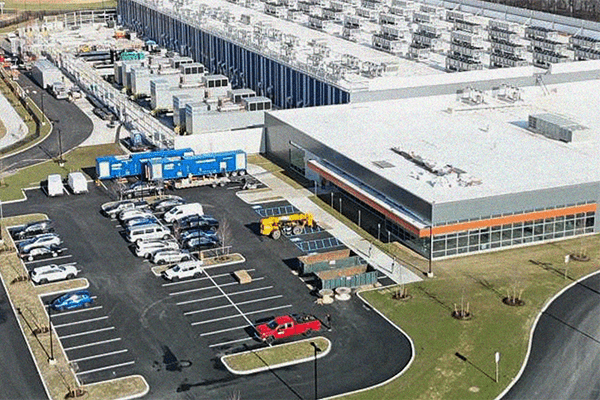|
RCBJ-Audible (Listen For Free)
|
Phase I Received Approvals Over Rockland County Planning Department Objections; Neighbors Raise Phase II Environmental And Fire Risk Issues
The Orangetown Planning Board on Wednesday will review an application by Databank to approve plans to construct a second data center at its facility at 2000 Corporate Drive in Orangeburg. Phase II includes a 146,000 square-foot building, and construction of a second substation on the 34-acre site.
Databank’s first phase, covering 145,000 square feet on the same parcel, had a ribbon cutting in May. The 20 megawatt (MW) facility is part of Databank’s three interconnected facilities in New York. Phase II, if approved, would be its fourth in New York State. According to its website Databank has more than 65 data centers in the United States.
The demand for new data centers continues unabated, driven largely by Artificial Intelligence (AI) and the ongoing demand for data processing and storage. The hottest states for data centers include Virginia, California and Texas, Illinois, Georgia and Ohio, but New York is not far behind, and Rockland County hosts a number of large data centers (over 100,000 square feet) in and around Orangetown.
The Rockland County Industrial Development Agency (IDA) has been instrumental in attracting data centers to Orangetown with generous sales tax exemptions on the costs of construction and equipment. The building of these facilities also brings hundreds of short-term construction jobs for these enormous projects.
Databank’s Phase II application includes the construction of a 146,000 square-foot data center, a 7,900 square foot expansion of its Phase I building, construction of a 73,000 square foot grid-connected substation, and a 52,000 square foot equipment yard.
2000 Corporate Drive sits on the border of New York and New Jersey, adjacent to Lake Tappan, a protected reservoir. The Orangetown Zoning Board of Appeals granted Databank several variances (parking and proximity to a residential district among them) before the Planning Board granted site approval.
Although Databank’s Phase I operation is already up and running in Orangeburg, neighbors and other planning professionals oppose the expansion.
The Rockland County Department of Planning reviewed Databank’s application on December of 2024 and unanimously disapproved of the application, citing the disruption of onsite wetlands, a high level of energy usage, lack of parking availability, and fire safety issues among their concerns.
The County Planning Department also raised concerns about zoning. In Orangetown, “data centers” are only listed as a permitted use within the RPC-OP zoning district, and although the town was considering adding data centers to the LIO district (where the site is located) as a conditional use, among other districts, no local law making that change was adopted.
The county also expressed concerns regarding energy use, the storage of batteries on site, and the preparedness of local fire officials.
Local residents have also weighed in in opposition to approval. They say there has not been an adequate environmental review under New York State Environmental Quality Review Act (SEQRA).
Neighbors in the residential areas have expressed concerns about the data centers’ proximity to the Lake Tappan reservoir, the construction over and adjacent to sensitive wetlands located on the property, and fire risks related to the storage of lithium-ion batteries on the site used to provide uninterrupted power in the event of a grid failure or power outage.
Neighbors on Buckingham Place in Old Tappan retained White Plains attorney Clifford Davis to express their opposition. In a letter dated June 30 to the Planning Board, Davis shares many of the same concerns raised by the Rockland County Planning Department related to zoning, particularly allowing data centers in a zone where they are not permitted under the Town Code. “Only the Town Board, and not this Board (referring to the Planning Board), has the right to enact zoning changes,” Davis wrote in a letter. “This Board cannot find zoning compliance when there is no zoning compliance.”
Davis also argues that Phase II of the project should be subject to a higher standard of review under SEQRA, and that the review was illegally segmented. Segmentation is the dividing of a project into different phases to minimize the overall environmental impact of each phase. New York law prohibits segmentation or the phasing of environmental reviews.
Davis has expressed concern that the Planning Board will gloss over potential environmental impacts and says, “Of course, there are adverse environmental impacts that need to be studied in an EIS (Environmental Impact Statement).”
Each phase on Databank’s project includes direct ties to the power grid, as well as backup generators, and a lithium-ion based array of batteries to provide uninterruptible power in the event of a power failure. The battery banks, also known as BESS (Battery Energy Storage Systems) have been the subject of controversy, as battery banks are subject to fire risk from “thermal runaway” caused many things including manufacturing defects, internal short circuits, high temperatures, overcharging, poor maintenance, aging infrastructure, human error, physical damage, or the introduction of water or high humidity.
The gases released during a fire caused by thermal runaway are considered hazardous, and lithium-ion fires are difficult to extinguish and are sometimes left to burn out.
Major fires from thermal runaway of lithium-ion battery banks are tracked on the BESS Failure Incident Database. Fires at data centers have occurred both domestically and abroad, with the most recent in May, according to WIRED magazine, in Oregon at a data center leased by X.
In 2023, Governor Kathy Hochul announced the creation of a New York State Inter-Agency Fire Safety Working Group to ensure the safety and security of energy storage systems across the State following several fire incidents within New York State, including those in Jefferson, Orange and Suffolk counties.
According to NYSERDA, battery energy storage systems (BESS) have the unique potential to make energy systems smarter, more affordable, and more resilient while creating cleaner air and healthier communities in the process. Because of these benefits, energy storage technologies are becoming increasingly common in New York State.
According to a spokesperson at NYSERDA, battery energy storage projects like the one proposed by Databank are permitted at the local level, not by New York State.
NYSERDA publishes the New York Battery Energy Storage System Guidebook, which contains information, tools, and step-by-step instructions to support local governments managing battery energy storage system development in their communities and provides local officials with in-depth details about the permitting and inspection process to ensure efficiency, transparency, and safety in their communities.
While the Planning Board will consider the proposed site plan and determine the scope and extent of its review under SEQRA, a number of variances are requested and must be approved before any final approvals can be issued. There are also other agencies that have jurisdiction over the wetlands, including the NYS DEC and the US Army Corp of Engineers.











